Boar Tusk
Boar Tusk is in Animal Artefacts.
The Amesbury Archer [Map] is the remains of a man aged around forty at the time of his death from the Alps who was buried in Amesbury around 2300BC and discovered in May 2002 during the development of new housing. He is named 'The Archer' as a consequence of the large number of arrowheads found with him. His grave contained the largest number of artefacts of any grave of a similar period including the earliest known gold objects in England, five beaker funerary pots, three tiny copper knives, sixteen barbed flint arrowheads, a kit of flint-knapping, metalworking tools including cushion stones and some boar tusks. On his forearm was a black stone wrist guard. A similar red wrist guard was by his knees with a shale belt ring and a pair of earrings, the oldest gold objects found in England. An eroded hole in his jaw showed that he had suffered from an abscess, and his missing left kneecap suggests that he had an injury that left him with a painful lingering bone infection. His remains are on display in the Salisbury and South Wiltshire Museum [Map].
The Amesbury Archer's Companion is the remains of a man raised locally aged between twenty-five and thirty at the time of his death buried around 2300BC near to the Amesbury Archer. He appears to be related to the Amesbury Archer as they shared a rare hereditary anomaly, calcaneonavicular coalition, fusing of the calcaneus and of the navicular tarsal (foot bones). Inside his jaw were found a pair of gold earrings or hair ornaments in the same style as the Amesbury Archer's.
Photos sourced from Salisbury and South Wiltshire Museum [Map] and Wessex Archaeology.
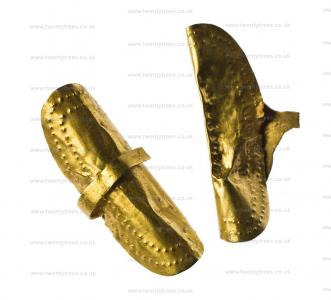
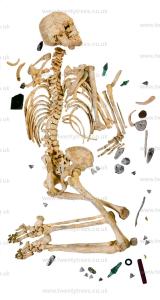
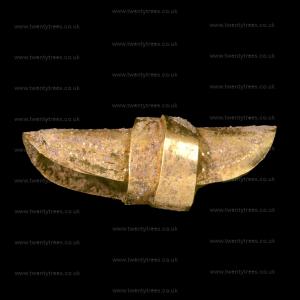
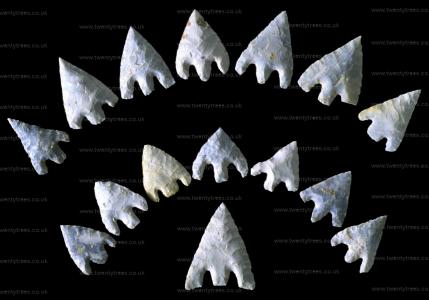
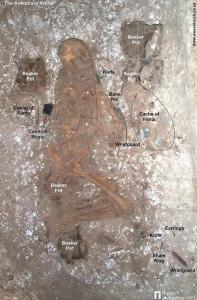
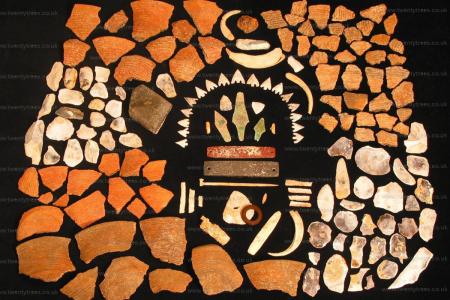
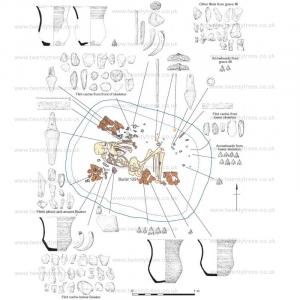
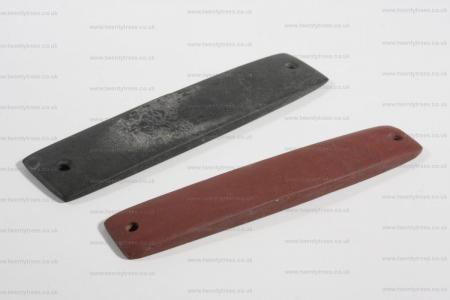
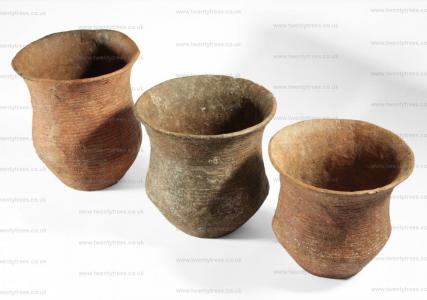
2300BC. Boscombe Bowmen [Map] is the remains of a shared burial of around 2300BC found at Boscombe Down Amesbury. The grave contained seven burials: three children, a teenager and three men. The teenager and men appear to have been related. The eldest man was buried in a crouched position with the bones of the others scattered around him, and their skulls resting at his feet. Several flint arrowheads, a boar tusk, flint tools and eight Beaker Ware vessels were found found with the remains. Lead isotope analysis indicates the men grew up in South Wales or the Lake District. The remains are on display at Salisbury and South Wiltshire Museum [Map].
Colt Hoare 1812. No. 18 [Map]. This large bell-shaped barrow, 121 feet in diameter, and 11 in elevation, may be considered as the monarch of this group, both as to its size, as well as contents. On the floor of the barrow we found the skeleton of a very tall and stout man, lying on his right side, with his head towards the south-east. At his feet were laid a massive hammer of a dark coloured stone. A brass celt, a tube of bone, a handle to some instrument of the same, a whetstone with a groove in the centre, and several other articles of bone, amongst which is the enormous tusk of a wild boar; but amongst these numerous relicks, the most curious article is one of twisted brass, whose ancient use, I leave to my learned brother antiquaries to ascertain. It is unlike any thing we have ever yet discovered, and was evidently fixed into a handle as may be seen by the three holes, and one of the pins still remaining: the rings seem to have been annexed to it for the purpose of suspension. This article, together with the celt and boar's tusk form a very interesting engraving, and are all drawn of the same size as the originals in Tumuli Plate XXIX.
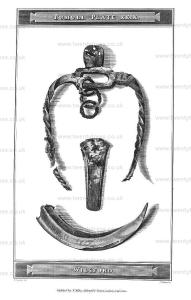
Section I Tumuli 1843. July 14th, 1843, one of the most interesting barrows ever examined in this vicinity was opened. It is situated upon a ridge of high land, near the village of Biggin, which goes by the name of the "Liffs [Map]," the barrow itself having no specific name: the mound had been sadly mutilated, at least one third of it having been removed; notwithstanding this the truth of Sir Richard Hoare's maxim, "fronta nulla fides," was agreeably exemplified. That hemisphere of the circle which still remained the most perfect was selected as the place where to commence operations: on reaching the thickest part of the circle, which, owing to the depression usual in the middle of most barrows, would be about two yards from the centre, a few human bones, horses' teeth, various animal bones, and two small pieces of a very thick and coarse urn, were found; but not until penetrating to the heart of the barrow was the principal interment discovered. In that situation an octagonal cist was erected of the usual material, namely, thin flat lime-stones, which are admirably adapted for the purpose; this vault was about half filled with stiff clay, imbedded in which lay a fine human skeleton, whose knees were drawn up, according to a general custom, prevalent in the most remote ages. The extreme antiquity of this interment is demonstrated by the simple form and material of the weapons and tools which were, with one exception, deposited in a cluster behind the shoulders of this early denizen of the Derbyshire moors. The skull, which is fine and intellectual, lay on the left side so as to look towards the west, and in the angle formed by the contraction of the knees, was placed a hammer-head ingeniously constructed out of the lower part of the horn of a noble red deer; one end of this instrument is rounded and polished, the other is cut into a diamond pattern, somewhat similar to the wafer stamps used by attorneys. The articles before alluded to as being placed near the shoulders were of a very miscellaneous character, and highly interesting; as showing, after a lapse of several thousand years, that the savage Briton reposing in this cairn had cultivated the art of making war amongst the inhabitants of the forest, in preference to molesting his fellow-savages; as almost the first observed articles were a pair of enormous tusks of the wild boar, the trophies of some, perhaps his last, sylvan triumph; next came two arrow-heads of flint, delicately chipped, and of unusual form; two flint celts or chisels, beautifully chipped and polished at the cutting edges; two spear-heads of the same material; two flint knives polished on the edge, one of them serrated on the back, in order to serve as a saw; and numerous other pieces of flints of indescribable form and use, which, together with all the flint instruments enumerated above, seem to have undergone a partial calcination being gray tinted with various shades of blue and pink; with these utensils were found three pieces of red ochre, the rouge of these unsophisticated huntsmen which, even now, on being wetted imparts a bright red colour to the skin, which is by no means easy to discharge. Upon the summit of the little heap, formed by this accumulation of relics, lay a small drinking or incense cup of novel and unprecedented shape, which was unfortunately broken and crushed, but has been since restored. The absence of instruments of metal in this and other barrows should be borne in mind; it is commented on in another part of this work.
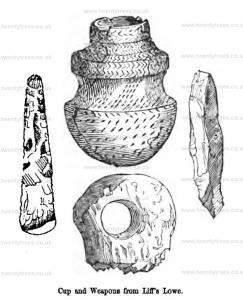
Section I Tumuli 1844. On the 31st of July, 1844, a small barrow [Map] on the One-ash Farm was opened; it was very low, being in no place more than a foot above the surrounding ground; owing to this circumstance the bones had been much disturbed and broken by the passing of the ploughshare over the mound. Near the centre of the barrow were the remains of a human skeleton, which had been accompanied by an ornamented drinking-cup, now broken to fragments; about the same place were perceived a great number of rats' bones, a few horse's teeth, a part of a boar's tusk, and a piece of rubbed sandstone, which had been burnt until it had become quite red, together with a few bits of flint. In other parts of the tumulus human bones were discovered, which would indicate this barrow to have been the resting-place of about six ancient Britons.
Since the above account was written it has been ascertained that this tumulus was opened in 1818, by Mr. Samuel Mitchell, who discovered part of a neatly-ornamented urn, about six inches in diameter, which had contained calcined bones; also some animal bones and an entire human skull.
Section I Tumuli 1844. On the 6th of August 1844 was opened a most interesting barrow upon Wardlow Common which is known by the name of Rolley Lowe [Map]; it is a mound of considerable magnitude, being forty-five feet in diameter, and five feet in height at the centre. As the discoveries made in this barrow are of a very miscellaneous character, and of various dates, it will be the most simple course to record them in the order in which they occurred: in the course of the central excavation, in which all the relics were found, about a foot from the surface, and dispersed amongst the soil which was found to be unmingled with stones to the depth of eighteen inches, were found a few human bones and teeth, and a third brass coin of Constantino the Great; near the bottom of this upper stratum of soil, where it began to be slightly mixed with stones, a brass pin, two inches and three quarters in length, square at the thicker end for insertion into a handle, was found. About three feet from the surface of the mound, a central area about eight feet in diameter was discovered, which seemed to be walled out in a circular form, and divided into five partitions by large limestones, so as to exhibit a ground plan similar to a roulette-table. There was no appearance of any of these vaults having been protected by coverings; when discovered, each was filled with small stones, amongst which lay the skeletons, which occupied all these partitions, whilst in one was also an urn. But to resume the particulars in the order before stated; in the first examined recess was a human skeleton, minus the head but complete in other respects; with this interment was deposited the under jaw of a child; in the next compartment was a skeleton without any accompaniment: in the following cist was a large and coarse urn, inverted over a deposit of calcined human bones, amongst which was a large red deer's horn, also calcined; the urn was about sixteen inches in height, and twelve in diameter; and, owing to its size and fragile texture, was broken to pieces in the attempt made to remove it; near the urn was a skeleton with a fine and well-preserved skull. In the last examined division, which was the northern-most, lay a human skeleton, with which were deposited a large horn from the red deer, and the jaw of an otter. Proceeding down about a foot lower than the level upon which all these skeletons were laid, another skeleton was found laid upon a large stone, on the level of the natural soil; it was accompanied by three rude instruments of flint, and the head lay directly beneath the large urn before mentioned: the stone in question measured in length six feet, and in breadth about four feet, being upon the surface of the ground it was at first thought to be rock but a piece being broken off, disclosed to view a sight such as is seldom witnessed by the barrow-digger, and which repays him for his frequent disappointments; this was a cist or vault, three feet in length, two feet in width, and eighteen inches in depth, formed of four smooth limestone slabs, having a fifth as a pavement, all the angles and joints having been so effectually secured by a pointing of tenacious clay, that not a particle of soil had entered this primitive coffin, the workmanship of which was in every respect neat and accurate. It was tenanted by a skeleton with contracted knees, whose bones, though much decayed, lay in the posture they had assumed on the decomposition of their fleshy covering; in the rear of the skeleton, was laid on one side a highly ornamented urn, of rude but chaste design, and in various situations in the cist were found two very neat arrow-heads of flint, of uncommon form, a large tusk of the wild boar, seven inches in length, and a piece of tempered clay, to which adhered some fragments of decayed wood. The excavation for the vault was made in the natural soil, and from the floor of the cist to the summit of the tumulus was at least six feet six inches. The undermentioned articles, which did not appear to be connected with any of the interments, were found in various situations, throughout the interior of the barrow; namely, a fragment of an ornamented drinking-cup, a spear-head of coarse flint, and similar workmanship, a few animal teeth, and rats' bones "ad infinitum." The outer circumference of the major part of this barrow was constructed of some description of clayey composition, which had become as hard as a turnpike road.
Diary of a Dean by Merewether. No. 27e. In the repeated examinations made in the upper mound within the circle and under the sarsens, ox and deer's bones and teeth, sarsens of considerable size, and boars' tusks were found. The excavations both in this part and in the long mound had been very extensive, and it must be confessed had resulted in something like disappointment, from the promise their appearance had held out. To Mr. Hillier, the occupier of this district, and his lady, who regaled us and a large party with a substantial tea repast, we were indebted for a most agreeable and acceptable mode of consolation, and the grand success of our efforts is yet to be related in the contents of the oval mound.
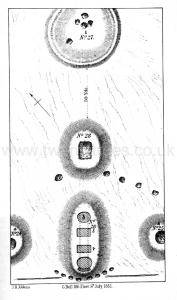
Diary of a Dean by Merewether. No. 15. This was a much larger and more elevated barrow, of the bowl shape, of about 3 feet in its elevation. It is not improbable that this had been before examined. We met with no regular cist or deposit, but fragments of rude pottery were plentiful; part of the bones of a human skull of remarkable thickness and development of the internal processes, two incisores teeth of a dog or fox, one tusk of a boar, and other teeth and bones in great variety; but in particular, a very beautiful and admirably chipped flint arrow-head (R). Having completed our investigation of these three barrows, we were invited by my good friend and a zealous Archæologist, Mr. Money Kyrle, the rector of Yatesbury, to proceed to his parish, where there were several barrows, said to be intact as yet. Whilst we were inspecting the Church, which, like Avebury, has of later times been converted in style to late decorated or perpendicular, but in which the south wall contains the piers and main arches of a Norman church, and the north aisle, at its west end, a very remarkable early English triplet window of very small size, and a very elegant and unique early English font, — the men were sent to commence operations on two mounds of large dimensions, but, judging from the irregularities of ground about them, of somewhat dubious character. In the mean time our attention was directed to the general and marked unevenness of surface in the fields of this parish—some of a peculiar character, as in one instance the appearance of a well in the centre of a considerable area formed by a mound of earth, in Cow Leaze—some at a part of the village called Town's-End— some near the house of Mr. Tenner—trenches more or less deep and important, with mounds in correspondence. It is not impossible that a detachment of forces, in their march previous to the battle of Roundaway Hill, near Devizes, may have halted here, and thrown up a hasty earthwork for their defence during the night, although the general unevenness in question cannot thus be accounted for. Let me here mention a little incident, which may possibly be useful in a similar way to future Archæologists. On seeing a blacksmith's shop near, I remarked that such an establishment should never be passed without a regard to the old iron and brass stores. On asking the principal Cyclops, (though I should beg his pardon, for he was father of the parish-clerk, one of our most strenuous coadjutors,) whether he ever had old spear-heads or such things brought to him with the old iron, he immediately admitted that he had many times, and thought he had somewhere one at that time, which, after a little search, was produced. It is of good workmanship, of the long four-sided shape. His son, hearing what was sought for, said there was another about the house, but it could not be found.
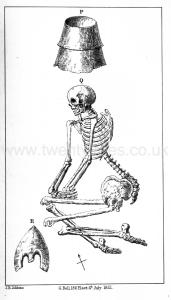
Waterhouses. On the 7th of April, we opened a barrow [Stonesteads Barrow [Map]] in a field called Stonesteads, a quarter of a mile from the village of Waterhouses, measuring 17 yards across, composed of earth, limestones, and boulders. Slightly South-East from the centre of the barrow, upon a pavement of thin flat stones raised 6 inches above the natural level of the land, lay the skeleton of a tall and strongly-built man, apparently beyond the middle period of life, who had been placed in the common flexed posture, with the head towards the outside of the tumulus. Near his feet was the tusk of a large boar, rubbed down on the inner surface to abput half the natural thickness, near the shoulders were two instruments of burnt flint, one round ended, the other, part of a neat arrow-point; and a section about half-an-inch long, cut from a large rib, and neatly dressed round the edge of the cut surfaces. On the floor of the barrow were indications of fire, and a few pieces of calcined bone, which render it probable that there had been a more ancient interment in the barrow, which was about eighteen inches in central elevation.
Over Haddon. May 4th we partially excavated the remains of Grindlow [Map] proper, originally a large cairn 25 yards across, wholly composed of stones of all sizes, but now almost demolished: we were therefore unsuccessful in our search for interments, but found broken human bones, accompanied by those of the rat, in every direction. We also met with a broken lance head of flint, and part of the tusk of a wild boar.
Ecton. On the evenings of the 11th and 12th of June we investigated a barrow [Probably Ecton Barrow 1 [Map]] on Ecton Hill, which was partially opened on the 18th of May, 1848. On the south side we found a deposit of burnt bones, which had been placed in a large urn, with a projecting border ornamented with diagonal lines, accompanied by two unburnt tines of the antler of the red deer. The urn was much broken when found. Towards the east side was a skeleton much broken and decayed, the head towards the outside; accompanied by a few burnt bones, fragments of earthenware, a few pieces of flint, and animal bones, including a boar's tusk. At the south-west side of the mound were more human bones, which had been disturbed by miners, who finding lead in the tumulus, had concluded it to be the site of an ancient bloomery or smelting-place, such being formerly established on hills for the sake of the draught; their locality is yet indicated by the word Bole, as Bole Hill, &c.
Chelmorton. On the 5th of July we resumed the examination of the barrow at Nether Low [Map], and found at the west side about five yards from the centre, four interments, three of which were placed in angle of a shallow depression in the rock, of irregular form. The most important of these was the skeleton of a middle aged man, lying contracted in the western angle, having beneath the head, and in contact with the skull, a beautiful leaf-shaped dagger of white flint, 4½ inches long, with the narrower half curiously serrated. A few inches from this unique weapon, was a plain but neat spear head of white flint. In a joint of the rock at a right angle with this interment, was a slender skeleton, probably of a female in the prime of life, accompanied by a prism-shaped piece of white flint, a piece of hematite, a boar's tusk, and a large globular bead of jet; the last found close to the neck.
The third skeleton was that of a much younger subject, and lay on the rock a little nearer the centre; it was not provided with implements, but between it and the others was a single piece of a calcined human skull. They were all about 4 feet from the top of the barrow.
Another skeleton was discovered about two feet from the surface, in a cist covered by a large flat stone and constructed across the joint of rock occupied by the female skeleton; it was accompanied by stags' horns of large size, and an arrow point of grey flint; and appeared to be the body of a person 17 or 18 years old.
In another cutting, near the outside, we found the remains of an infant, and a very neat instrument of white flint of uncertain use.
Bailey Hill. On the 3rd of August we opened a barrow on Bailey Hill [Map], between the Dove and Bostom, on the Derbyshire side of the stream. It was raised upon a very irregular protuberant rock, which in the middle was cut through the loose upper beds into a kind of grave, the bottom of which, conforming to the dip of strata, was three feet deep at one end, whilst it diminished to nothing at the other. In this were three interments, the most primitive of which had been disturbed by the later deposits, its bones being found at intervals from the surface downwards. The bones were those of a full-grown person, and much decayed. A second skeleton was found undisturbed at the bottom, on which it lay on its right side, with the body slightly curved, the knees contracted, and the head to the west. Before the face was a small plain vase, lying on its side, and at the back of the skull was a very large tusk from the wild boar. The femur measures about 16 J inches. About a foot below the surface was a deposit of calcined bones, containing a very neatly made pair of tweezers of bone, unbumt, and perforated for suspension. The grave was filled up with stone, and the artificial part of the roound consisted of similar materials, amongst which rats' bones so much abounded as to fill up most of the interstices from the surface to the bottom of the grave. A few pieces of two vessels were picked up during the day. The following remarks upon the barrow, made by Mr. Carrington immediately after the opening, are valuable. He says — "I consider this to be the most primitive barrow I ever opened, as the small instrument of bone may have been deposited with the burnt bones at a much more recent period than that in which the mound was originally constructed. The coarse urn, without any decoration — the absence of every other article, with the exception of the boar's tusk — serve to strengthen this supposition. The contents of the cist were examined with the greatest care, yet nothing more was discovered, except one small round piece of ironstone — not a sandstone, or pebble, or charcoal (which are all commonly found in Celtic barrows) — not even one bit of flint was to be seen. This is the first barrow I have opened in which the latter material has not been present."
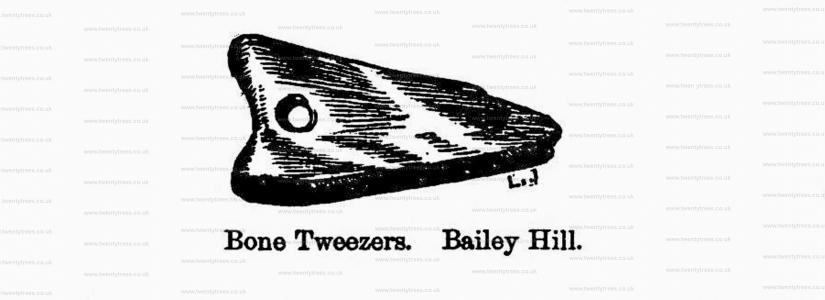
Stakor Hill. In the afternoon, we made four trenches in another barrow, situated on a neighbouring eminence, called Anthony Hill [Map]. It measures about fourteen yards across, and is not more than a foot in height, having been removed to within a few inches of the natural soil. Many fragments of human bone, and a boar's tusk, were found just under the turf, but no depression in the natural level being observed, it became evident that all the interments were destroyed from not having been buried deeper.